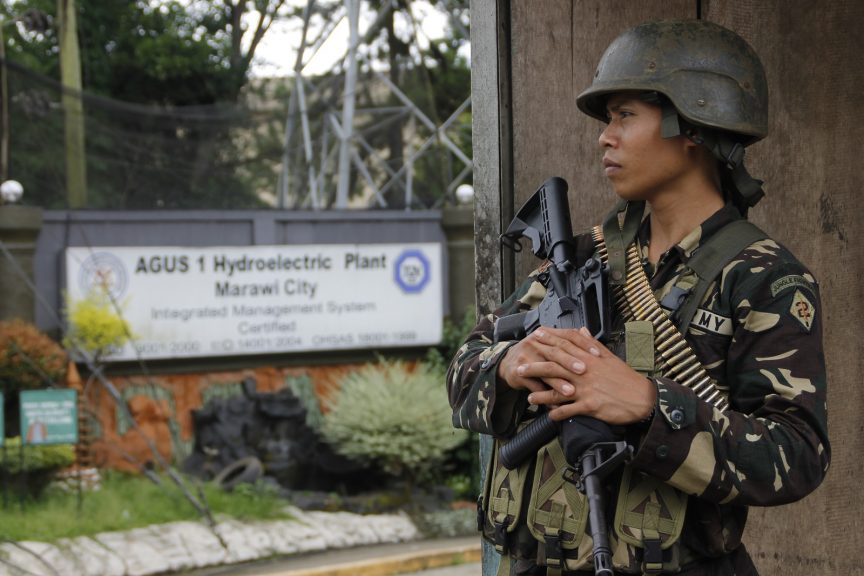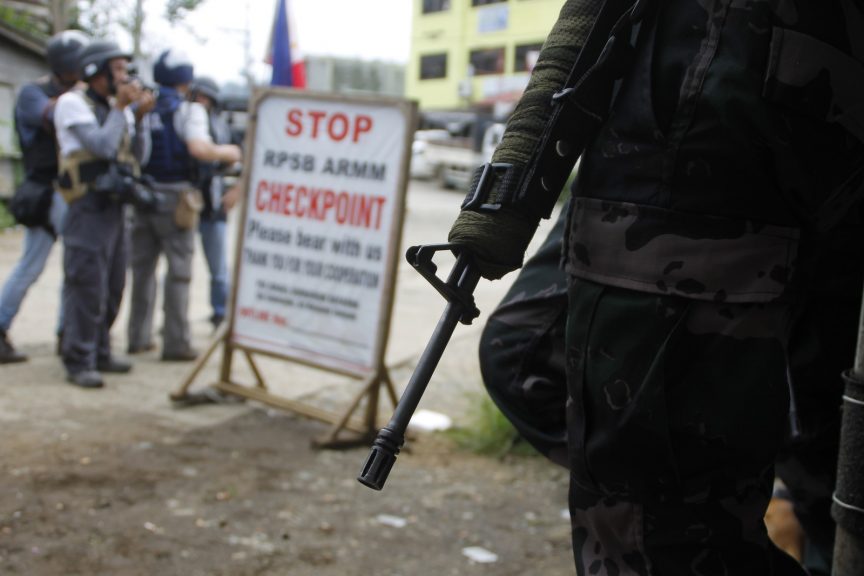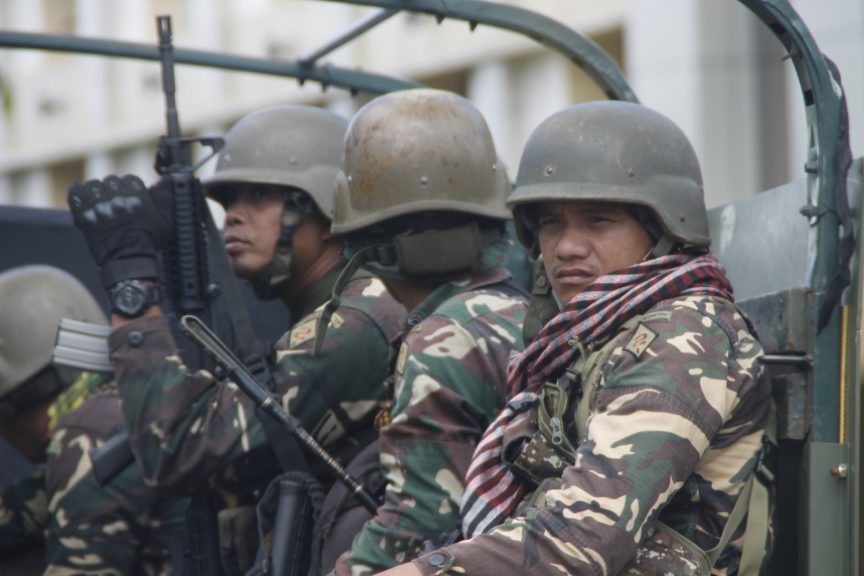MARAWI CITY (MindaNews/26 June) — Chants of “Allahu Akbar” echoed inside the mosque at the Lanao del Sur provincial capitol complex as dozens of Maranao faithful performed their midday prayer on Friday (June 23), two days before the holy month of Ramadan ended. Outside, however, the sight of military trucks and Simba tanks going to and coming from the battlefront in the city’s downtown area provided stark contrast to the solemn air inside the place of worship.
 A soldier stands guard outside the Agus 1 hydropower plant in Marawi City on Sunday, June 25, 2017. MindaNews photo by H. Marcos C. Mordeno
A soldier stands guard outside the Agus 1 hydropower plant in Marawi City on Sunday, June 25, 2017. MindaNews photo by H. Marcos C. Mordeno
In past weeks, soldiers, police, civilians and journalists could be seen spending idle hours at the porch of the capitol building. Watching the daily bombing sorties has become a sort of sordid pastime for them, the sound of exploding bombs and rockets fired from combat aircraft reminding them that this big, little war against shadowy ISIS-inspired radicals, the Maute Group, is far from over.
As such, any amount of optimism could be premature as yet. In fact, additional troops are being deployed at close intervals to take the place of wounded personnel whose latest number now approximates a battalion, something that government forces haven’t had experienced within the same time span in the war against the New People’s Army.
Last week, soldiers at the checkpoint near the entrance to this city said each Army division has already sent a battalion each. Add to this the Marines and policemen and it is safe to estimate that at least 5,000 military and police have had seen action here. The sustained deployment gives the impression that the siege would last longer than expected.
Consider: The air strikes began on May 25, two days after the militants occupied portions of the city and forced its residents to flee to other towns and cities. At times the bombings extended into the night. Yet, a month after, there are no signs these have scared the wits out of the attackers much less pushed them back. If the bombardment has accomplished anything at this stage, it is the gradual destruction of the city not the annihilation of the aggressors.
 Journalists gather in Barangay Datu Saber, Marawi City on Sunday, 25 June 2017, while waiting for the outcome of negotiations for the safe passage of some civilians who were trapped in a conflict zone. MindaNews photo by H. Marcos C. Mordeno
Journalists gather in Barangay Datu Saber, Marawi City on Sunday, 25 June 2017, while waiting for the outcome of negotiations for the safe passage of some civilians who were trapped in a conflict zone. MindaNews photo by H. Marcos C. Mordeno
And each day that passes only brings more anxiety — and more casualties. As of June 21, sixty-six soldiers and police had been killed, and as of June 14, some 300 others had been wounded in action. The military said the Maute Group has lost 268 fighters. This is aside from the 26 civilian casualties. But the fact that the military continues to use aerial bombardment suggests that the body count means little in the larger scheme of things.
This has led many to wonder how the Maute fighters have become a headache to the strategists in the Philippine military. While the answers may not come soon, what is certain is that in the first month of hostilities they have managed to outfight security forces based on the manpower-casualty ratio. The military placed enemy strength at around 200-250, and later at around 500, but this could be an arbitrary estimate.
Another question is how they have sustained their firepower as the siege wears on. One logical source is the weapons and ammunition from fallen adversaries. Those in the know surmised that the militants may have accessed too the weapons left behind by civilians in their homes when they fled for safety. A place prone to rido or clan feud, [most] residents consider keeping guns for self-defense a fact of life, although some wouldn’t admit it.
Regardless of how they have managed to keep the siege going, occupying Marawi’s built-up areas has proved to be a brilliant choice by the Maute fighters. There the buildings and residences that were built with reinforced concrete — designed for rido, they would say — provide refuge as well as good vantage points for their snipers. Besides, as locals, they know the layout and details of the terrain.
And if it’s true that underneath those buildings is a network of drainage arteries, it could explain why the bombing raids have been ineffective. A source interviewed late last month said these underground canals are as wide as an adult’s arm stretch and around six feet high, big enough for three persons to walk or run alongside each other. The militants would just scamper to these underground sanctuaries at the sound of approaching aircraft.
 Anxiety shows on the face of an Army soldier on the way to a conflict zone in Marawi City on Sunday, June 25, 2017. MindaNews photo by H. Marcos C. Mordeno
Anxiety shows on the face of an Army soldier on the way to a conflict zone in Marawi City on Sunday, June 25, 2017. MindaNews photo by H. Marcos C. Mordeno
Compared to the place they first tried to control, Butig town in Lanao del Sur where the terrain fits the military’s expertise in jungle warfare, this city’s innards give the Maute fighters a better chance to at least prolong the conflict. Like rats they can surface any moment, hit an enemy or two, and run back to their holes to avoid retaliatory fire.
In the coming days, the militants may run out of food and ammunition — and with it they may lose too the will to fight. But for now, they seem to be dictating the tempo, leaving the cats clawing in the dark. (H. Marcos C. Mordeno/MindaNews)
